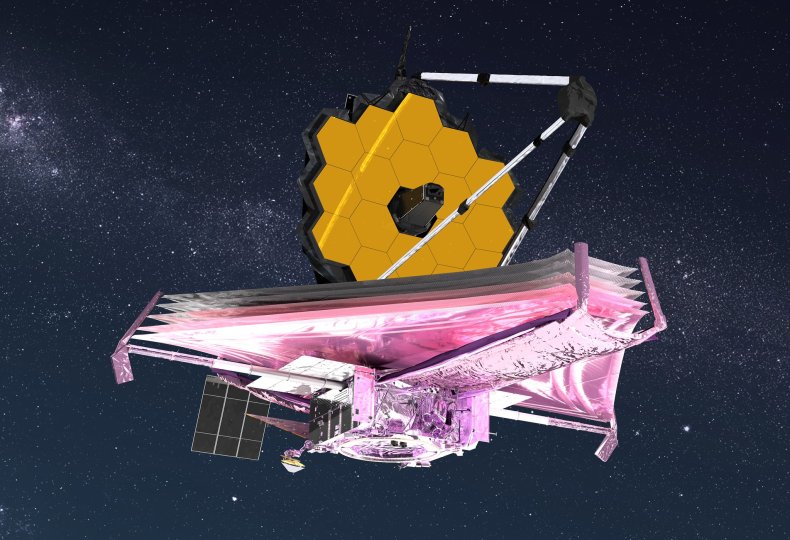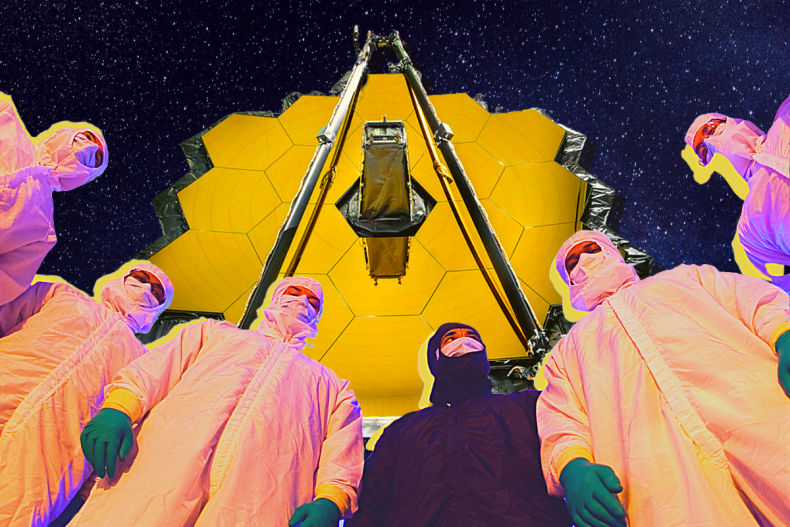The James Webb Space Telescope (JWST)—the largest and most powerful space observatory ever built—is almost ready to launch, and the observatory is set to have a "tremendous" impact on the search for alien life.
A collaboration between NASA, the European Space Agency and the Canadian Space Agency, the long-delayed, $10 billion dollar telescope promises to revolutionize our understanding of the universe by enabling scientists to gaze further into space than ever before and unlock the secrets of the very first stars and galaxies.
The observatory—the successor to the pioneering Hubble Space Telescope—will also examine our own solar system in unprecedented detail, shed light on the mysteries of dark matter, and much more.
One of JWST's main goals will be to conduct detailed observations of planets, which could have significant implications when it comes to the search for life beyond the Earth.
"Webb will have a tremendous impact on the search for life beyond Earth because it will be able to study in unprecedented detail the atmospheres of thousands of extra-solar planets floating around the galaxy. This is a game-changer for the field," Claudia Maraston, a professor of astrophysics with the Institute of Cosmology and Gravitation at the University of Portsmouth in the U.K., told Newsweek.
Among the planets Webb will study are worlds located in the "habitable zones" of distant stars—the regions within which liquid water could exist on the surface. JWST will attempt to identify the building blocks of life as we know it on these worlds, which are often described as "Earth-like."
Since the first planet outside our solar system—known as an "exoplanet"—was discovered in the early 1990s, scientists have identified thousands more in the Milky Way, many of which are referred to as Earth-like. It is now believed that planets are commonplace in the universe.
Laura Kreidberg, from the Max Planck Institute for Astronomy in Germany, told Newsweek: "JWST will provide a first look at the atmospheres of rocky exoplanets. We know that rocky planets are extremely common in the galaxy—there are tens of billions of them!
"But we still have many basic unanswered questions about these rocky exoplanets—do they have atmospheres or not? If so, what are the primary molecules that make up their atmospheres? JWST will go a long way in answering these basic questions, and set the stage for later searches for life."
In its first year of science, JWST is slated to observe the TRAPPIST-1 system, which is located "only" 39 light-years away—very close in astronomical terms. This particularly promising system hosts seven rocky planets, at least three of which lie in the habitable zone of the star and might have conditions similar to Earth.
Inside the solar system, the telescope will study, among other worlds, the atmosphere and surface of Titan, Europa and Enceladus—moons of Jupiter and Saturn that could potentially harbor some form of life.
According to Kreidberg, Webb will offer "revolutionary" new capabilities compared to Hubble due, primarily, to its much larger mirror—measuring 6.5 meters (21.3 feet) in diameter as opposed to 2.5 meters (8.2 feet). This will allow it to collect significantly more data in a single snapshot. In addition, Webb is optimized to "see" the universe in infrared wavelengths.
Hubble observes the universe primarily in shorter ultraviolet and visible light wavelengths. But when it comes to studying planets, the information that we can obtain in those wavelengths is often limited by the effect of the clouds that surround them. Infrared telescopes can essentially peer into the parts of the universe that are hidden from other observatories.

"That will allow us to pierce through the clouds and finally see what the atmospheres of planets are made of," Mercedes López-Morales, a researcher at the Harvard-Smithsonian Center for Astrophysics in Cambridge, Massachusetts, who will be using the observatory after it launches, told Newsweek. "In terms of the search for life beyond Earth, JWST will produce ground-breaking observations of potentially habitable environments in our own solar system and beyond."
Finding the building blocks of life
Webb search for the building blocks of life on exoplanets using a technique called transmission spectroscopy. This involves observing exoplanets as they pass in front of their stars and measuring the starlight that gets filtered through their atmospheres, in order to learn about the chemical compositions.
Sean Brittain, department chair and professor in the Department of Physics and Astronomy at Clemson University, South Carolina, told Newsweek: "Each molecule and atom absorbs and emits light at specific frequencies. The frequencies that molecules and atoms emit at are referred to as their 'spectrum.' This is like a fingerprint—every molecule or atom has a unique spectrum.
"By looking at the spectra of atmospheres, we will be able to measure the presence of different chemicals. The more of a given chemical there is, the more pronounced its spectrum."
An infrared telescope is key to characterizing the atmospheres of these planets because it is at these wavelengths that the molecules within them have the largest number of spectral features. Planets also emit far more light in infrared wavelengths than in visible light. While other infrared telescopes have been launched into space previously, Webb is much larger and more powerful than anything that has come before.
For example, Webb is 60 times more sensitive than NASA's Spitzer Space Telescope, which was retired last year. The telescope is so sensitive, in fact, that it could theoretically detect the heat signature of a bumblebee at the distance of the moon, according to the space agency.
JWST will provide, for the first time, data in the infrared where many signatures of molecules in exoplanetary atmospheres, such as methane, carbon dioxide and water—some of the ingredients required for life—can be detected, according to López-Morales.
"If certain molecules—like carbon dioxide and methane—are abundant, that would tell us that there is non-equilibrium chemistry occurring," Brittain said. "What this means is that there has to be a process that produces these molecules in steady state as they do not tend to survive around one another. This could mean that there is life there."
While Webb will be able to measure gases in the atmospheres of Earth-like planets with unprecedented sensitivity, experts warn that this alone will not be surefire evidence of life.
Harold Connolly Jr., a professor at Rowan University in New Jersey who is currently involved with two asteroid sample return missions—NASA's OSIRIS-Rex and the Japanese Space Agency's (JAXA) Hayabusa2—told Newsweek: "In my thinking, we will never be able to prove definitively through the data collected by JWST that a specific planetary body contains life.
"Habitable, most likely yes, or at least by our current definition of what life needs to survive, but life for certain, I don't think so," he said. "That stated, through future data collected by Webb we will be able to increase our level of confidence that specific bodies are prime candidates for more detailed investigations."
According to Maraston, the proof for life will need to wait for the direct detection of a biosphere, namely, a composition that can only be made by existing life.
"This will have to wait for future generation missions. However, the results obtained by James Webb will be crucial to define the targets for the future missions, making them feasible and effective. We should not forget that there are billions of stars in our Milky Way and we need to search on target!"
These future missions will involve searching for what scientists call "biosignatures"—any characteristic element, molecule, or substance that can be used as evidence for life, past or present.
The presence of oxygen and water is a strong biosignature, as is the combination of ozone and water in the same atmosphere—or methane and oxygen. Taking the former case as an example, this combination could be an indication that some form of life is undergoing the process of photosynthesis.
JWST has not been designed to search for biosignatures—this will require even more sensitive technology. While there is very slim possibility that it could detect them, experts said this would be pushing the capabilities of the observatory to its absolute limit.
Ernst de Mooij and Chris Watson, both researchers from Queen's University Belfast in the U.K., told Newsweek: "The search for potential biosignatures is fraught with challenges. Not only will any signals be small and difficult to detect, but there are also significant possibilities of finding false-positives, where signals are falsely attributed to biological origins, as well as false-negatives—where genuine signals may be attributed to other causes."
Kreidberg, who is director of the Atmospheric Physics of Exoplanets (APEx) Department at the Max Planck Institute, said JWST will not be able to "definitively" identify biosignatures.
"To definitively identify life, we need a complete and precise chemical census of all the molecules in a rocky planet atmosphere," she said.
Kreidberg said it would be "very, very challenging" for Webb to identify biosignatures—something that will only happen under very unlikely and specific circumstances.
"Basically, we would have to get lucky. If a handful of the very best planets—i.e. the closest, most observable—had the exact right combination of gases in their atmospheres, and are not too cloudy, we might be able to detect biosignature gases," she said. "That's a lot of ifs!"
Nevertheless, Webb is capable of identifying the basic building blocks of life on other planets, which will be a "huge step" in understanding whether a planet is habitable or not, according to Kreidberg.
"It can help us better determine the temperature at the planet's surface, and asses the chances that it has liquid water. Just knowing this would be a big deal, even if it isn't a definitive detection of life," she said.
Webb will also provide us for the first time with the data needed to understand the range of potentially habitable planets that exist in the universe.
"Right now we only have Earth, Venus, and Mars as examples, but we might find out that there are many more environments suitable for life," López-Morales said.
Knicole Colón, an exoplanet scientist with the JWST project at NASA's Goddard Space Flight Center in Maryland, told Newsweek: "Webb's journey is just starting, and we are continuing to discover more exoplanets all the time, so I am excited to see what Webb will learn as it explores the atmospheres of known and as-yet-undiscovered distant worlds!"


Post a Comment